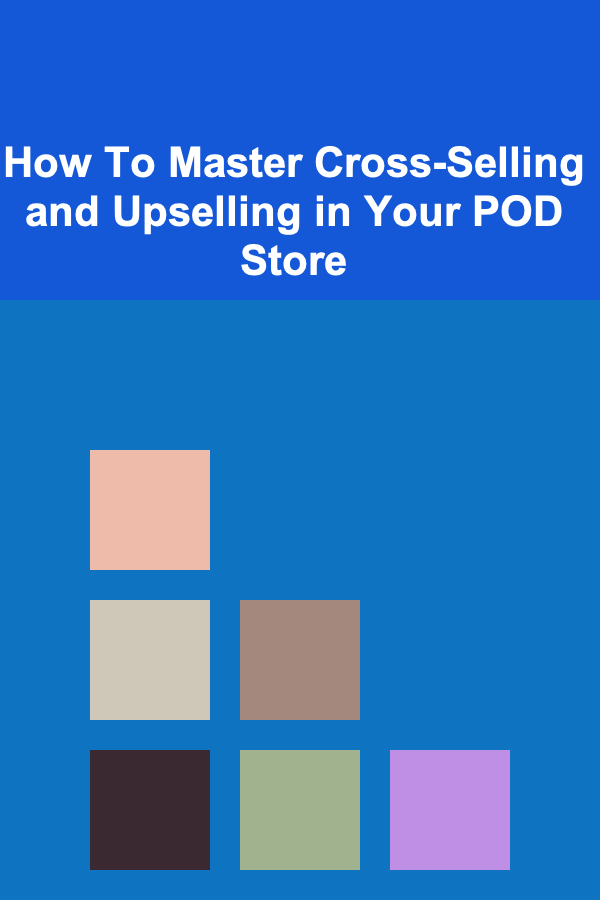
How To Master Cross-Selling and Upselling in Your POD Store
ebook include PDF & Audio bundle (Micro Guide)
$12.99$10.99
Limited Time Offer! Order within the next:

In the world of e-commerce, particularly in Print-on-Demand (POD) businesses, increasing revenue without significantly increasing costs is a constant challenge. One of the most effective ways to boost sales is by mastering cross-selling and upselling strategies. Both techniques can help you maximize the lifetime value of your customers, improve customer experience, and ultimately increase profits.
This article explores the core concepts of cross-selling and upselling in the context of a POD store, provides practical tips for implementing these strategies, and discusses how you can integrate them into your sales process to achieve long-term success.
Understanding Cross-Selling and Upselling
Before diving into the strategies for applying cross-selling and upselling, it's important to define these two terms.
Cross-Selling
Cross-selling involves suggesting related or complementary products to customers who are already making a purchase. The goal is to increase the average order value (AOV) by encouraging the customer to buy products that enhance or go well with their initial purchase.
In the context of a POD store, a cross-sell could be suggesting a matching phone case when a customer buys a t-shirt with a particular design, or recommending a matching mug when they purchase a custom-designed pillow.
Upselling
Upselling, on the other hand, is the practice of encouraging the customer to buy a higher-end version of the product they're interested in. This might involve offering a more expensive item that has additional features, premium quality, or customization options that appeal to the customer's needs or preferences.
For example, in a POD store, upselling could mean encouraging a customer to purchase a hoodie instead of a basic t-shirt or offering them an upgraded design or material for their product.
Both strategies are designed to increase the total sale, but the approach for each is slightly different: cross-selling expands the range of products a customer buys, while upselling increases the value of what they already want to purchase.
Why Cross-Selling and Upselling Are Essential for Your POD Store
In a competitive market like POD, your goal is not only to attract new customers but also to make the most of each customer interaction. Here's why mastering cross-selling and upselling is essential for your store:
-
Increased Revenue Without Increasing Customer Acquisition Costs
Getting a new customer can be expensive, especially when factoring in the costs of ads, marketing, and promotions. On the other hand, selling more to existing customers is cost-effective. Cross-selling and upselling increase the average order value (AOV), allowing you to generate more revenue from the same traffic.
-
Better Customer Experience
When done right, cross-selling and upselling don't just serve your financial goals; they also provide value to the customer. By recommending complementary or higher-quality products that align with their needs or interests, you can enhance their shopping experience. This leads to more satisfied customers who are likely to return.
-
Improved Customer Retention
Customers who feel that a brand understands their preferences and needs are more likely to become repeat buyers. Personalizing your cross-sell and upsell strategies ensures that customers feel that the suggestions you make are relevant to them, increasing the likelihood of them returning for future purchases.
-
Leveraging the Power of Recommendations
Cross-selling and upselling tap into the psychology of customers who are already willing to spend money. According to research, customers are more likely to buy additional products if they trust the store and the product suggestions feel like helpful, value-adding advice rather than hard sales tactics.
How to Implement Cross-Selling and Upselling in Your POD Store
Now that we understand the benefits of cross-selling and upselling, let's explore how to implement these strategies effectively in your POD store.
1. Know Your Products and Your Audience
Understanding your products and your customer base is the foundation for any cross-selling and upselling strategy. You need to be aware of the kinds of products that work well together and understand your customers' preferences and buying behaviors.
- Analyze Customer Behavior: Use analytics tools to track customer interactions on your site, including the types of products they browse, add to their cart, and purchase. This will give you insights into which products are frequently bought together, which can inform your cross-selling strategy.
- Product Bundles: Create bundles of related products that appeal to customers who are likely to buy them together. For instance, if your store specializes in custom t-shirts, you could create a bundle of t-shirts and matching accessories (like hats, bags, or scarves). These can be promoted as a set for a discounted price.
- Know Your Best Sellers: Keep track of your best-selling products and think about how you can offer additional items that complement these popular items. For example, if your custom posters are selling well, consider offering frames or wall art that would pair nicely with them.
2. Use Product Recommendations
An easy and effective way to cross-sell and upsell is by showing product recommendations on your product pages, in the shopping cart, and during checkout. These recommendations should be personalized to the customer based on what they've previously viewed or purchased.
- Product Recommendations on Product Pages: Display products that are commonly bought together, or products that are related to the item a customer is viewing. For example, if a customer is looking at a custom-designed mug, you could display a related mug design or a matching coaster.
- Shopping Cart Suggestions: When a customer adds an item to their cart, show additional items they might like. This could be based on the customer's browsing history, popular products, or relevant items. For example, if someone is purchasing a phone case, suggest a matching phone stand or screen protector.
- Checkout Page Upselling: During checkout, offer the customer an opportunity to upgrade their purchase, like offering a premium version of the product, an extended warranty, or a related item that enhances their original purchase.
3. Offer Discounts and Bundles
Discounts and bundles can be a powerful way to encourage both cross-selling and upselling. When a customer feels they're getting a better deal, they're more likely to add more items to their cart.
- Bundle Pricing: Offer customers the opportunity to save by purchasing related products together. For instance, if a customer is buying a custom shirt, offer them a deal where they can get a matching mug or tote bag for a discounted price.
- Volume Discounts: You can offer discounts for purchasing multiple items. This could be applied to cross-selling (e.g., buy one shirt and get a second one at 20% off) or upselling (e.g., buy a basic design and get an upgraded design for a discounted price).
- Loyalty Discounts: Encourage repeat customers by offering loyalty discounts when they return to your store and make a second purchase. For example, you could offer a discount on their next order if they buy a higher-end version of a product.
4. Leverage Email Marketing for Cross-Selling and Upselling
Email marketing is an excellent tool for both cross-selling and upselling. You can reach out to customers after they make a purchase and suggest products that are relevant to their interests.
- Post-Purchase Emails: Send emails that thank customers for their purchase and recommend complementary items based on their buying history. For example, if a customer purchases a custom t-shirt, send them an email suggesting other apparel items or accessories that go well with their purchase.
- Abandoned Cart Emails: If a customer adds products to their cart but doesn't complete the purchase, send an email reminding them of their abandoned cart. You can use this as an opportunity to cross-sell or upsell related products. For example, if they abandoned a purchase for a t-shirt, you might suggest a matching hoodie or an upgraded design.
- Personalized Recommendations: Use customer data to send personalized product recommendations based on their past behavior, location, and preferences.
5. Create a Sense of Urgency
Urgency can be a powerful motivator for customers to act quickly. When done strategically, it can help drive both cross-selling and upselling.
- Limited-Time Offers: Use limited-time offers to encourage customers to purchase additional items. For example, offer a discount on a complementary item if they buy within the next 24 hours.
- Low Stock Alerts: Notify customers when a product they've shown interest in is running low on stock. Pair this with a suggestion for a similar, higher-priced item that is in stock to upsell them.
- Flash Sales: Hold flash sales on certain products and encourage customers to buy more items during the sale. Offer bundle discounts or exclusive products to incentivize higher-value purchases.
6. Optimize the Mobile Experience
With the increasing use of smartphones for online shopping, optimizing your POD store's mobile experience is crucial for successful cross-selling and upselling. Ensure that your product pages load quickly, product recommendations are visible, and the checkout process is smooth.
- Responsive Design: Ensure that your website is mobile-friendly and responsive. This ensures customers can easily browse products, view recommendations, and make purchases without frustration.
- Mobile Pop-ups: Use pop-ups on mobile to show personalized recommendations or special offers. These should be subtle but effective in encouraging customers to add additional items to their cart.
7. Provide Excellent Customer Service
At the heart of both cross-selling and upselling is a customer-first mentality. To successfully implement these strategies, you need to ensure that your customers feel valued and supported throughout their shopping experience.
- Personalized Interactions: Use live chat, customer support, or AI-driven recommendations to provide personalized product suggestions based on customer preferences or previous interactions.
- After-Sales Follow-Up: Send a thank-you email after a purchase and ask for feedback. This shows that you care about their experience and opens the door for you to introduce more products that might interest them in the future.
Conclusion
Mastering cross-selling and upselling is an essential part of growing your POD business. By understanding your products, leveraging smart recommendations, and optimizing your sales process, you can significantly boost your revenue without incurring high additional costs. Always remember that the key to success with these techniques is to offer relevant, value-adding products that improve your customers' experience.
By following these strategies, you can not only increase your sales but also build stronger, more loyal relationships with your customers.
Reading More From Our Other Websites
- [Home Family Activity 101] How to Host a Family Puzzle Night for Bonding
- [Home Pet Care 101] How to Ensure Your Pet Receives Quality Care with Highland Pet Care
- [Trail Running Tip 101] Conquering Peaks: Essential Trail-Running Techniques for Mountain Terrain
- [Home Storage Solution 101] How to Keep Your Small Apartment Clutter-Free with Smart Storage Solutions
- [Home Budget 101] How to Save for a Dream Home While Sticking to Your Budget
- [Personal Investment 101] Using Deep Learning to Create AI Products for Passive Income
- [Home Rental Property 101] How to Ensure Your Rental Property is Compliant with Local Laws
- [Home Pet Care 101] How to Handle Pet Allergies in the Home
- [Personal Care Tips 101] How to Choose Hand Cream with Antioxidants for Skin Protection
- [Home Pet Care 101] How to Keep Your Pet's Teeth Clean and Healthy

How to Design a Space-Saving Home Office in a Tiny Room
Read More
How to Secure Your Home's Wi-Fi Network from Hackers
Read More
How to Set Your Translation Rates for Maximum Profit
Read More
Mastering Account Management: Essential Skills for Success in Client Services
Read More
How To Use Photography Apps Effectively
Read More
Navigating Time Zone Differences in Remote Work
Read MoreOther Products

How to Design a Space-Saving Home Office in a Tiny Room
Read More
How to Secure Your Home's Wi-Fi Network from Hackers
Read More
How to Set Your Translation Rates for Maximum Profit
Read More
Mastering Account Management: Essential Skills for Success in Client Services
Read More
How To Use Photography Apps Effectively
Read More